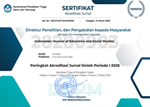Malee, S. Z. B., & Mohd Balwi, M. A. W. F. B. (2021). Ensuring Environment, Social & Financial Sustainability during a Pandemic: The Story of a Singapore Mosque. Journal of Muslim Minority Affairs, 41(4), 703-718. https://doi.org/10.1080/13602004.2022.2034683
Braun, V., & Clarke, V. (2022). Conceptual and Design Thinking for Thematic Analysis. Qualitative Psychology, 9(1), 3. https://doi.org/10.1037/qup0000196
Dawadi, S., Shrestha, S., & Giri, R. A. (2021). Mixed-methods Research: A Discussion on Its Types, Challenges, and Criticisms. Journal of Practical Studies in Education, 2(2), 25-36. https://doi.org/10.46809/jpse.v2i2.20
Derevyanko, N., & Zalevska, O. (2023). Comparative Analysis of Neural NETWORKS Midjourney, Stable Diffusion, and DALL-E and Ways of Their Implementation in The Educational Process of Students of Design Specialities. Series “Pedagogy and Psychology”, 3(9), 36-44. https://doi.org/10.52534/msu-pp3.2023.36
Hernandez-de-Menendez, M., Escobar Díaz, C., & Morales-Menendez, R. (2020). Technologies for The Future of Learning: State of The Art. International Journal on Interactive Design and Manufacturing (IJIDeM), 14, 683-695. https://doi.org/10.3846/jau.2021.13709
Idham, N. C. (2021). Javanese Islamic Architecture: Adoption and Adaptation of Javanese and Hindu-Buddhist Cultures in Indonesia. Journal of Architecture and Urbanism, 45(1), 9-18. https://doi.org/10.3846/jau.2021.13709
Kocaman, İ., & Kazaz, I. (2023). Global Drift Ratio Limits for Historical Masonry Mosques. Bulletin of Earthquake Engineering, 21(5), 3011-3040. https://doi.org/10.1007/s10518-023-01613-1
Kudless, A. (2023). Hierarchies of Bias in Artificial Intelligence Architecture: Collective, Computational, and Cognitive. International Journal of Architectural Computing, 14780771231170272. https://doi.org/10.1177/14780771231170272
Lak, A., Gheitasi, M., & Timothy, D. J. (2020). Urban Regeneration through Heritage Tourism: Cultural Policies and Strategic Management. Journal of Tourism and Cultural Change, 18(4), 386-403. https://doi.org/10.1080/14766825.2019.1668002
Longhurst, G. J., Stone, D., & Smith, C. F. (2020). Strength, Weakness, Opportunity, Threat (SWOT) Analysis of The Adaptations to Anatomical Education in The United Kingdom and Republic of Ireland in Response to the Covid‐19 pandemic. Anatomical sciences education, 13(3), 301-311. https://doi.org/10.1002/ase.1967
Lyu, Y., Wang, X. & Wu, J. (2022). Communication in Human–AI Co-Creation: Perceptual Analysis of Paintings Generated by Text-to-Image System. Applied Sciences, 12(22), 11312. https://doi.org/10.3390/app122211312
Meyer, M. W., & Norman, D. (2020). Changing Design Education for the 21st Century. She Ji: The Journal of Design, Economics, and Innovation, 6(1), 13-49.
Mittal, S., Chadchan, J., & Mishra, S. K. (2020). Review of Concepts, Tools and Indices for the Assessment of Urban Quality of Life. Social Indicators Research, 149, 187-214. https://doi.org/10.1007/s11205-019-02232-7
Mubarak, H., Muntaqa, A. W., Abidin, A. M. A. Z., Sudrajat, D., & Syakhrani, A. W. (2022). The Technological Revolution and The Dynamics of Islamic Da'wah. At-Tajdid: Jurnal Pendidikan dan Pemikiran Islam, 6(1), 44-58. https://doi.org/10.24127/att.v6i1.1806
Nasrollahzadeh, N. (2021). Comprehensive Building Envelope Optimization: Improving Energy, Daylight, and Thermal Comfort Performance of The Dwelling Unit. Journal of Building Engineering, 44, 103418. https://doi.org/10.1016/j.jobe.2021.103418
Nesbit, P. R., Boulding, A. D. (2020). Visualization and Sharing of 3D Digital Outcrop Models to Promote Open Science. GSA Today, 30(6), 4-10. https://doi.org/10.1130/GSATG425A.1
Pearson, A. (2023). The Rise of CreAltives: Using AI to Enable and Speed Up the Creative Process. Journal of AI, Robotics & Workplace Automation, 2(2), 101-114.
Putri, M. A., Abbas, E. W., & Jumriani, J. (2021). Strategies in Developing Creative Economic Activities Based on Local Wisdom. The Innovation of Social Studies Journal, 3(1), 42-48. https://doi.org/10.1186/s41235-020-00243-4
Rasrichai, K., Chantarutai, T., & Kerdvibulvech, C. (2023). Recent Roles of Artificial Intelligence Artists in Art Circulation. Digital Society, 2(2), 1-14. https://doi.org/10.1007/s44206-023-00044-4
Spence, C. (2020). Senses of Place: Architectural Design for The Multisensory Mind. Cognitive Research: Principles and Implications, 5(1), 46. https://doi.org/10.1186/s41235-020-00243-4
Tamm, T., Hallikainen, P., & Tim, Y. (2022). Creative Analytics: Towards Data‐Inspired Creative Decisions. Information Systems Journal, 32(4), 729-753. https://doi.org/10.1111/isj.12369
Wang, W., Sun, L., Liu, T., & Lai, T. (2022). The Use of E-health during the COVID-19 Pandemic: A Case Study in China’s Hubei Province. Health Sociology Review, 31(3), 215-231. https://doi.org/10.1080/14461242.2021.1941184
Wang, X., Liu, A., & Kara, S. (2022). Machine Learning for Engineering Design Toward Smart Customization: A Systematic Review. Journal of Manufacturing Systems, 65, 391-405. https://doi.org/10.1080/14461242.2021.1941184
Yeung, A. W. K., Tosevska, A., Klager, E., Eibensteiner, F., Laxar, D., Stoyanov, J., & Willschke, H. (2021). Virtual and Augmented Reality Applications in Medicine: Analysis of The Scientific Literature. Journal of Medical Internet Research, 23(2), e25499. https://doi.org/10.2196/25499
Zhang, C., & Lu, Y. (2021). Study on Artificial Intelligence: The State of the Art and Future Prospects. Journal of Industrial Information Integration, 23, 100224. https://doi.org/10.1016/j.jii.2021.100224
 (Universitas Pembangunan Nasional “Veteran”)
(Universitas Pembangunan Nasional “Veteran”) 



